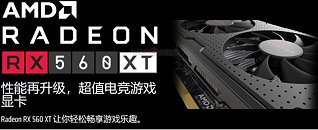Wednesday, March 13th 2019

AMD Brings Back the "XT" Moniker with China-specific Radeon RX 560 XT
Back in the glory days of ATI Radeon, the XT brand extension denoted the better-endowed variant among two or more graphics card models based on the same silicon, such as the Radeon HD 2900 XT. After AMD's takeover, the XT, Pro, XL, and other lesser used extensions such as XTX and All-in-Wonder were retired in favor of numerical variant numbers, beginning with the HD 3870. The company continued to use "XT" and "Pro" internally to differentiate ASIC variants, although those monikers were seldom if not never used in marketing materials. That's about to change. AMD launched its first overtly XT brand-extended product in close to 15 years, with the China-specific Radeon RX 560 XT, but alas, it's a lousy re-brand.
The RX 560 XT is positioned between the RX 560 4 GB and RX 570 4 GB, and is based on the "Polaris 20" or "Polaris 30" silicon (we don't know which). AMD enabled 28 out of 36 NGCUs on this silicon, resulting in 1,792 stream processors, 112 TMUs, and 32 ROPs. The memory is 4 GB across a 256-bit wide memory interface, although the memory clock-speed is dialed down to 6.6 Gbps (211.2 GB/s). What makes the RX 560 XT a re-brand is that AMD launched an SKU with the same exact specifications, called Radeon Pro 570, and there are several odd-ball RX 570-branded cards in the wild with this core-config. There's no reference-design board of the RX 560 XT, and the SKU is entirely in the hands of board partners to come up with custom-designs of their own.
Update: AMD has informed us that the RX 560 XT is based on the 14 nm "Polaris 10" silicon, and not "Polaris 20" or "Polaris 30." Polaris 10 is the first implementation of the "Polaris" architecture.
The RX 560 XT is positioned between the RX 560 4 GB and RX 570 4 GB, and is based on the "Polaris 20" or "Polaris 30" silicon (we don't know which). AMD enabled 28 out of 36 NGCUs on this silicon, resulting in 1,792 stream processors, 112 TMUs, and 32 ROPs. The memory is 4 GB across a 256-bit wide memory interface, although the memory clock-speed is dialed down to 6.6 Gbps (211.2 GB/s). What makes the RX 560 XT a re-brand is that AMD launched an SKU with the same exact specifications, called Radeon Pro 570, and there are several odd-ball RX 570-branded cards in the wild with this core-config. There's no reference-design board of the RX 560 XT, and the SKU is entirely in the hands of board partners to come up with custom-designs of their own.
Update: AMD has informed us that the RX 560 XT is based on the 14 nm "Polaris 10" silicon, and not "Polaris 20" or "Polaris 30." Polaris 10 is the first implementation of the "Polaris" architecture.

31 Comments on AMD Brings Back the "XT" Moniker with China-specific Radeon RX 560 XT
As for the separate identifier, I guess that puts the lie to Gigabyte's claim of a bespoke binning process, as that's a clear sign of AMD doing the binning. I still wouldn't chalk up the new ID to anything more than binning, though - it still has identical specs to the base Polaris 20 XTX (boost clocks are determined per SKU, and AMD doesn't publish any specs for an XTR die), and again, the difference is no bigger than Nvidia's TUXXX-A chips.
Frankly, I'd be pretty happy if the RX 600 series (if they keep that naming scheme) consisted of Navi cards from RX 670 and upwards, with RX 660 and below being rebranded Polaris 10/20/30 cards (obviously at more reasonable clocks than currently to keep power draw in check). This has been done extensively in the past by both AMD and Nvidia, and it's a great tactic for providing serious performance increases at lower price points. A ~$120 Polaris 10/20 RX 660 with RX 480-ish specs would be an epic budget card, and would sell like hotcakes even if draws 150W. Of course this is pure speculation, but it would be quite nice to see.